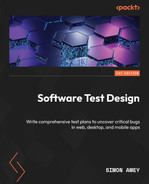A guide to writing comprehensive test plans covering exploratory testing and feature specification; black and white box testing; security, usability, and maintainability; and load and stress testing Software Test Design details best practices for testing software applications and writing comprehensive test plans. Written by an expert with over twenty years of experience in the high-tech industry, this guide will provide you with training and practical examples to improve your testing skills. Thorough testing requires a thorough understanding of the functionality under test, informed by exploratory testing and described by a detailed functional specification. This book is divided into three sections, the first of which will describe how best to complete those tasks to start testing from a solid foundation. Armed with the feature specification, functional testing verifies the visible behavior of features by identifying equivalence partitions, boundary values, and other key test conditions. This section explores techniques such as black- and white-box testing, trying error cases, finding security weaknesses, improving the user experience, and how to maintain your product in the long term. The final section describes how best to test the limits of your application. How does it behave under failure conditions and can it recover? What is the maximum load it can sustain? And how does it respond when overloaded? By the end of this book, you will know how to write detailed test plans to improve the quality of your software applications. This book is for anyone testing software projects for mobile, web, or desktop applications. That includes Dedicated QA engineers managing software quality, Test and test automation engineers writing formal test plans, Test and QA managers running teams responsible for testing, Product owners responsible for product delivery, and Developers who want to improve the testing of their code.Key Features
Book Description
What you will learn
Who this book is for
Table of Contents
- Software Test Design
- Contributors
- About the author
- About the reviewer
- Preface
- Part 1 – Preparing to Test
- Chapter 1: Making the Most of Exploratory Testing
- Chapter 2: Writing Great Feature Specifications
- Chapter 3: How to Run Successful Specification Reviews
- Chapter 4: Test Types, Cases, and Environments
- Part 2 – Functional Testing
- Chapter 5: Black-Box Functional Testing
- Chapter 6: White-Box Functional Testing
- Chapter 7: Testing of Error Cases
- Chapter 8: User Experience Testing
- Chapter 9: Security Testing
- Chapter 10: Maintainability
- Part 3 – Non-Functional Testing
- Chapter 11: Destructive Testing
- Chapter 12: Load Testing
- Chapter 13: Stress Testing
- Conclusion
- Appendix – Example Feature Specification
- Index
- Other Books You May Enjoy
